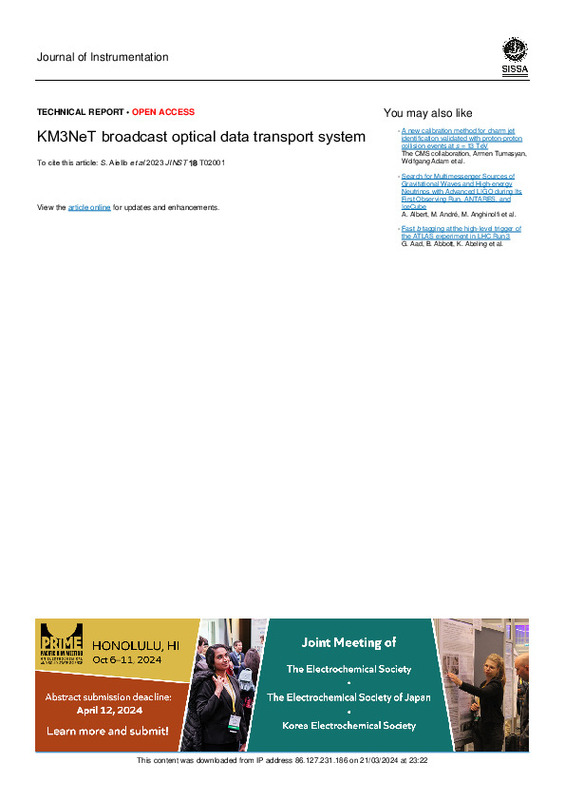|
Resumen:
|
[EN] The optical data transport system of the KM3NeT neutrino telescope at the bottom of the Mediterranean Sea will provide more than 6000 optical modules in the detector arrays with a point-to-point optical connection to ...[+]
[EN] The optical data transport system of the KM3NeT neutrino telescope at the bottom of the Mediterranean Sea will provide more than 6000 optical modules in the detector arrays with a point-to-point optical connection to the control stations onshore. The ARCA and ORCA detectors of KM3NeT are being installed at a depth of about 3500 m and 2500 m, respectively and their distance to the control stations is about 100 kilometers and 40 kilometers. In particular, the two detectors are optimised for the detection of cosmic neutrinos with energies above about 1 TeV (ARCA) and for the detection of atmospheric neutrinos with energies in the range 1 GeV-1 TeV (ORCA). The expected maximum data rate is 200 Mbps per optical module. The implemented optical data transport system matches the layouts of the networks of electro-optical cables and junction boxes in the deep sea. For efficient use of the fibres in the system the technology of Dense Wavelength Division Multiplexing is applied. The performance of the optical system in terms of measured bit error rates, optical budget are presented. The next steps in the implementation of the system are also discussed.
[-]
|
|
Agradecimientos:
|
The authors acknowledge the Foton Institute for providing all the reports concerning the cited measure-ments performed at the their facilities in the years 2014-2015 during the Phase I architecture design. The authors ...[+]
The authors acknowledge the Foton Institute for providing all the reports concerning the cited measure-ments performed at the their facilities in the years 2014-2015 during the Phase I architecture design. The authors acknowledge the financial support of the funding agencies: Agence Nationale de la Recherche (contract ANR-15-CE31-0020) , Centre National de la Recherche Scientifique (CNRS) , Commission Europenne (FEDER fund and Marie Curie Program) , Institut Universitaire de France (IUF) , LabEx UnivEarthS (ANR-10-LABX-0023 and ANR-18-IDEX-0001) , Paris Ile-de-France Region, France; Deutsche Forschungsgemeinschaft (DFG), Germany; The General Secretariat of Research and Innovation (GSRI), Greece Istituto Nazionale di Fisica Nucleare (INFN) , Ministero dell'Universite della Ricerca (MIUR), PRIN 2017 program (Grant NAT-NET 2017W4HA7S) Italy; Ministry of Higher Education, Scientific Research and Innovation, Morocco, and the Arab Fund for Economic and Social Development, Kuwait; Nederlandse organisatie voor Wetenschappelijk Onderzoek (NWO), the Netherlands; The National Science Centre, Poland (2021/41/N/ST2/01177) ; National Authority for Scientific Research (ANCS), Romania; Ministerio de Ciencia, Innovacion, Investigacion y Universidades (MCIU) : Programa Estatal de Generacion de Conocimiento (refs. PGC2018-096663-B-C41,-A-C42,-B-C43,-B-C44 and refs. PID2021-124591NB-C41,-C42,-C43) (MCIU/FEDER, Generalitat Valenciana: Prometeo (PROMETEO/2020/019) , Grisolia (refs. GRISOLIA/2018/119,/2021/192) and GenT (refs. CIDEGENT/2018/034,/2019/043,/2020/049,/2021/023) programs, Junta de Andalucia (ref. A-FQM-053-UGR18) , La Caixa Foundation (ref. LCF/BQ/IN17/11620019) , EU: MSC program (ref. 101025085) , Spain; Maria Zambrano program within the framework of grants for retaining in the Spanish university system (Spanish Ministry of Universities, funded by the European Union, NextGenerationEU) .
[-]
|









